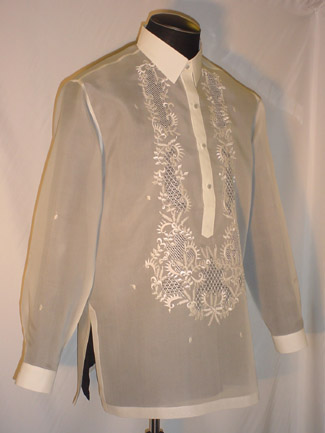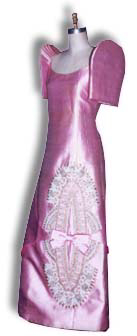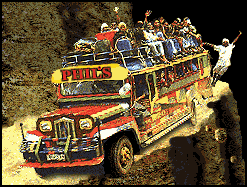6 to 8 or more
players
Outdoors
The players are divided into two teams of equal number. The
ground is marked off in a rectangle about five to six meters,
divided into four equal parts. Diagram A is for 6 players, B for 8
or more players.
Winning the toss entitles the players on that team to be
runners. The taggers stand on lines 1, 2, and 3. Number 1 can go
anywhere to tag the runners. The objective of the runners is to get
through all the lines (1, 2, 3) back and forth without being
tagged. Taggers 1 and 2 tag the runners as they cross their lines
or as they get near them. As soon as one of the runners crosses
line 3, he returns to line 1 and calls out, "Tubig!" This means a
night (a point) is scored in favor of his team. The team
which scores three consecutive "nights" (or three points) is the
winner, and will be the runners of the next game.
If a runner is tagged while crossing a line or while trying to
cross, the teams exchange places.
PENALTIES:
1. The losers carry the winners on their backs, to and fro.
2. The winners pat the hands of losers 10 to 20 or more times.
Cockfighting
/Sabungan
Although cockfighting is illegal in
most countries, nevertheless, it is considered the king of sports in
the Philippines. Since this sport is so popular, almost all the
towns in the country have a cock pit (sabungan). One can expect to
see excited and boisterous crowds at the galleries around the
central pits on every Sunday or public holiday.
There are many fights per day,
resulting in thousands of pesos changing hands at each fight. The
proper fight begins after the referee has unsheathed the razor-sharp
spur attached to both cocks' right legs and allowed each fighter a
sharp peck at the opponent's neck. After being led into a fighting
mood, the cocks are then let loose from opposite ends of the arena
to a fight of death. During the fight, the combatants do a swift
combination of clawing, pecking and stabbing with their miniature
scimitars. The defeated fighter will scurry to one end of the arena
and crumples into a heap. This marks the end of the game, as the
winner is ready for the next match.
Basketball
Basketball is one of the most
popular national sports in the Philippines. Although Filipinos are
slightly at a disadvantage in terms of height, nonetheless, they are
among the best basketball players in the world. The popularity of
this national passion is marked by year-round amateur competitions,
school championships, provincial meets, professional as well as
international tournaments.
The love for this game is evident
as every town plaza has a basketball court alongside the town hall
and church. Even from an early age, boys play this game using a
makeshift basket.
SIPA
Pronounced as: see-pah
Uses a coin-like object (washer)
with colorful threads attached to it. This is then kicked (sipa)
into the air by the player as many times as he can without the
"sipa" falling on the floor.
TAGUAN
Pronounced as: tah-gu-ahn
This is also known as
hide-and-seek. As usual, an "it" is selected and while he counts
out loud (ie. 1-30), eyes closed on a "home base", the rest of the
players find a place to hide. Once the time is out, the "it" tries
to find the other players. If one is spotted, the "it" shouts
"boong ". The two ("it" and player) races to the
home base to touch it (shouts: "save" upon touching home base).
The first player that loses the
race, becomes the next "it". The "it" can then continue to find
the others, but a new "it" is already guaranteed to replace him.
The other players, if they find out, can continue to challenge
"race" the "it" to the base without getting spotted or just give
themselves up.
TUMBANG PRESO
Pronounced as: tum-bahng
preh-so
This is a relatively simple game.
At least 3 players are needed, although the more, the merrier.
First, select the "it" or the defender. Next, find a can, or
something that can be knocked over easily from a distance.
Position this can in the center of the game area (this will be
it's home plate or base). The game is played as follows.
The "it" will defend the can from
being knocked down. While it is in the upright position, the "it"
can chase anyone and tag him/her. When a player is tagged, and the
can is still in the upright position, that player becomes the new
"it".
The rest of the players must then
see to it that the can is always knocked down. The "it" of course
can always put it back in the upright position. The rest of the
players usually use their slippers to knock the can from a
distance. Or if one gets close enough to the can without getting
tagged, he can kick it and pick-up the rest of the "weapons" or
slippers used. Of course, it is usually up to the other players to
get their own "weapons" or slippers. For fairness, it would be
nice if the players had only two slippers to knock down the can,
no more than that. Once all the players are out of slippers, this
would be a major opportunity for the "it" to chase everyone before
the can is kicked. The can has to be positioned in a particular
area of responsibility.

Filipino
Damit (dress)
 Barong tagalog
Barong tagalog
'Barong is actually short for Barong Tagalog, which describes
the formal men's wear of the Philippines. It is properly referred to
as the 'Baro ng Tagalog' (dress of the Tagalog). Contracting the
first two words produces 'Barong,' which literally means 'dress of.'
So, if we want to be correct, we wouldn't say just 'Barong.' But,
the slang way of referring to one of the beautiful formal shirts is
simply Barong. Yes, the Barong Tagalog is a dress, a garment, a coat
in itself. It is not merely a 'shirt'. If it were, then it would
need a coat or a jacket over it to qualify as formal wear and would
have to be worn tucked inside the trousers.
'Baro' = Word for 'dress' in the Philippines, Tagalog dialect
'Baro ng Tagalog' = 'dress of the Tagalog' describes the formal
'dress' or upper garment for men in the Philippines
'Barong Tagalog' = contracted form of the above
'Barong' = literally means 'dress of' - but commonly used to refer
to the formal men's wear in the Philippines--my barong
 Maria Clara dress formal women's wear
of Filipinas
Maria Clara dress formal women's wear
of Filipinas
The coming of the Spaniards in the 16th century brought a new
influence in Philippine life. A majority of the Filipinos were
converted to Roman Catholicism. European cultural ideas spread and
the Filipinos adapted and blended to meet the local conditions.
These dances reached their zenith in popularity around the turn of
the century, particularly among urban Filipinos.
They are so named in honor of the legendary Maria Clara, who
remains a symbol of the virtues and nobility of the Filipina woman.
Maria Clara was the chief female character in Jose Rizal’s “Noli Me
Tangere.” Displaying a very strong Spanish influence, these dances
were, nonetheless, “Filipinized” as evidence of flamenco
style posturing and movements. Typical attire for these dances for
the women is the formal “Maria Clara” dress that
imitated the Spanish ballgown from the eras of influx of their
influence. Typical attire for these dances for the men is the
“Barong Tagalog,” an embroidered long-sleeve shirt made of
pineapple fiber or “jusi.”--Maui
Filipino Profiles Read on!
http://home.online.no/~erfalch/profile.htm

Transportation
 Saan ba talaga naggsimula ang Jeepney?
Saan ba talaga naggsimula ang Jeepney?
Nakakatuwa talaga
ang pinoy, isa sa mga ugali natin ay ang malikhain pag iisip. Nung
umalis ang mga Kano sa Pinas pagkatapos ng pangalawang digmaan isa
sa naiwan nila ay ang Army Jeep, dahil sa galing ng Pinoy nagawa
nila ng paraan kung papaano magamit ito at pakinabangan ng lahat.
Hanggang sa ito na nilakihan at binago ang model upang
makasakay ang maraming tao. Kung sa ibang bansa bus lang ang uso
dito ay pati jeepney. At ang nakakatuwa pa walang jeep na
magkakatulad, pa iba iba ang mga accessories at pintura nito isa
lamang patunay na artistic talaga tayo , yung iba nga dyan may music
pa parang disco house ang loob. ( Marami pa naman sa mga estudyante
namimili ng jeep gusto may music!)
Paano ba pag sakay?
Ang normal na paraan ay hanapin ang lugar kung saan ang babaan at
sakayan ng jeep.May ibat ibang ruta ang jeepney, una ay basahin mo
lang ang naka lagay sa sign board ng jeep (saan ba banda ang vice
versa, dyok !) kung nabasa mo na pwede mo siyang kawayan at ito'y
hihinto. Kung gusto mong sigurado ka kung dadaan ito sa lugar mong
gustong puntahan o kaya'y hindi ka maligaw itanong mo lang sa mamang
sumisigaw tawag sa kanila ay konduktor (hindi sila doktor usually
may kasama silang DJ= dispatcher ng jeep).Minsan nag loload ng mga
pasahero sa unloading areas, siympre dasal ka lang na hindi ka
mahuli ng MMDA/pulis. Pag ikaw ay nasa loob ng jeep (maraming
nakakatuwang quotes "basta driver sweet lover" o kaya'y katas
ng saudi or homesick versus dollar, siyempre hindi na rin mawawala
ang rosary na nakasabit sa salamin ng driver), pwede ka derektang
magbayad sa driver kung walang konduktor , hindi na kelangan ng
tiket hindi tulad ng bus. Sa pagbabayad ng pasahe laging dasal ng
driver na tama ang ibinabayad ng bawat pasahero. Kaya nga iba sa
kanila naglalagay ng "God Knows Judas Not Pay". Huwag kakalimutang
pumara (pwede rin katuking ang bubong ng jeep) kung baba ka na sa
lugar ng babaan mo.
 Kalesa or karitela
is a horse-driven carriage that was
introduced during the 18th century. It was used by Spanish officials
and the nobles as a means of transportation. The Ilustrados, the
rich Filipinos who had their own businesses, used the kalesa not
only for traveling but as a means a means of transporting their
goods as well.
Kalesa or karitela
is a horse-driven carriage that was
introduced during the 18th century. It was used by Spanish officials
and the nobles as a means of transportation. The Ilustrados, the
rich Filipinos who had their own businesses, used the kalesa not
only for traveling but as a means a means of transporting their
goods as well.